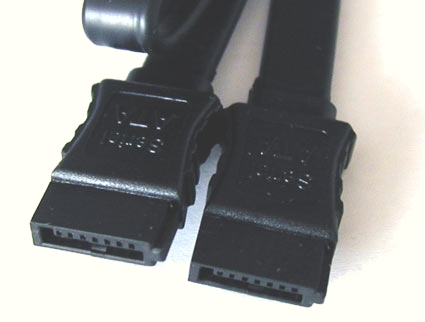All Aboard! P4 with 200 MHz FSB and the i875P Dual DDR400 Chipset
The Basics: Serial ATA
As opposed to the classical UltraATA standard, Serial ATA no longer works simultaneously through multiple data circuits and is instead content to use a total of four circuits. Pairs of connections are better protected from kinks and twists than the plain ribbon cables. This means that Serial ATA can be used with very high clock frequencies - similar to other serial protocols, such as USB and FireWire, or the usual connections between the northbridge and southbridge of a chipset, such as HyperTransport (AMD) or V-Link (VIA). At 150 MB/s, the maximum theoretical data transfer rate is at a good level, even though this is hampered by the PCI bus: here, a maximum of 133 MB/s is possible at 33 MHz and 32 Bit.
The cable length is restricted with high clock speeds, but up to one meter is possible, and this is considerably more leeway than the maximum of 45 cm with UltraATA. There are in fact longer UltraATA cables, but they are a far cry from the specification. With Serial ATA, the connectors also shrink in size. And finally, they are safe from polarity reversal, making installation difficulties a thing of the past.
Get Tom's Hardware's best news and in-depth reviews, straight to your inbox.
Current page: The Basics: Serial ATA
Prev Page Southbridge 82801EB/R (ICH5) Next Page Serial ATA Configuration: With Or Without RAID
